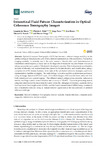Intraretinal Fluid Pattern Characterization in Optical Coherence Tomography Images

Use este enlace para citar
http://hdl.handle.net/2183/25418
Excepto si se señala otra cosa, la licencia del ítem se describe como Atribución 4.0 Internacional (CC BY 4.0)
Colecciones
- Investigación (FIC) [1685]
Metadatos
Mostrar el registro completo del ítemTítulo
Intraretinal Fluid Pattern Characterization in Optical Coherence Tomography ImagesAutor(es)
Fecha
2020-04-03Cita bibliográfica
de Moura, J.; Vidal, P.L.; Novo, J.; Rouco, J.; Penedo, M.G.; Ortega, M. Intraretinal Fluid Pattern Characterization in Optical Coherence Tomography Images. Sensors 2020, 20, 2004. https://doi.org/10.3390/s20072004
Resumen
[Abstract] Optical Coherence Tomography (OCT) has become a relevant image modality in the ophthalmological clinical practice, as it offers a detailed representation of the eye fundus. This medical imaging modality is currently one of the main means of identification and characterization of intraretinal cystoid regions, a crucial task in the diagnosis of exudative macular disease or macular edema, among the main causes of blindness in developed countries. This work presents an exhaustive analysis of intensity and texture-based descriptors for its identification and classification, using a complete set of 510 texture features, three state-of-the-art feature selection strategies, and seven representative classifier strategies. The methodology validation and the analysis were performed using an image dataset of 83 OCT scans. From these images, 1609 samples were extracted from both cystoid and non-cystoid regions. The different tested configurations provided satisfactory results, reaching a mean cross-validation test accuracy of 92.69%. The most promising feature categories identified for the issue were the Gabor filters, the Histogram of Oriented Gradients (HOG), the Gray-Level Run-Length matrix (GLRL), and the Laws’ texture filters (LAWS), being consistently and considerably selected along all feature selector algorithms in the top positions of different relevance rankings.
Palabras clave
Optical Coherence Tomography
Texture analysis
Feature selection
Computer-aided diagnosis
Classification
Feature analysis
Texture analysis
Feature selection
Computer-aided diagnosis
Classification
Feature analysis
Versión del editor
Derechos
Atribución 4.0 Internacional (CC BY 4.0)
ISSN
1424-8220






